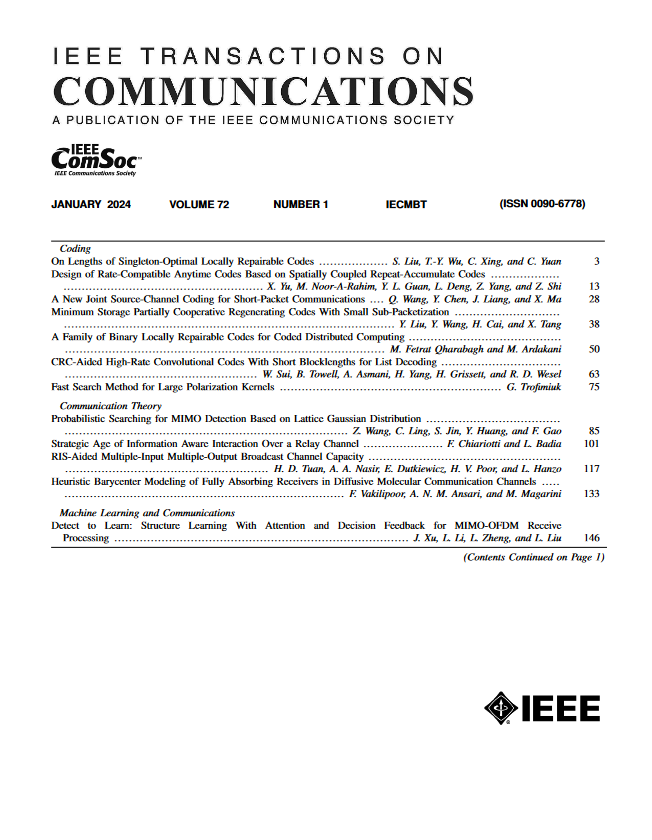Quasi-Neural Network-Based Decoder for Single-Carrier Communications
IF 8.3
2区 计算机科学
Q1 ENGINEERING, ELECTRICAL & ELECTRONIC
引用次数: 0
Abstract
This paper proposes a novel algorithm, named a quasi-neural network-based decoder (QNN-decoder), for a single-carrier communication system. The algorithm is designed for an inter-symbol-interference (ISI) channel that a trellis diagram can model. According to the trellis diagram, a quasi-neural network (QNN) is built to acquire the likelihoods of the received samples enabling the subsequent decoding. The QNN-decoder differs from artificial neural network (ANN) based algorithms, such as the online learning trellis diagram (OLTD), as it doesn’t rely on data but instead utilizes the physical system model. This means the QNN-decoder can use a much shorter pilot to train its network via backpropagation than OLTD. Meanwhile, the QNN-decoder doesn’t require explicit channel state information (CSI) or statistics of interference and noise. Instead, it can efficiently suppress non-Gaussian interference by learning the CSI and interference and noise statistics. Simulation results verify the QNN-decoder outperforms the state-of-the-art methods and approaches the performance limits provided by the conventional Viterbi with perfect CSI in Gaussian noise only. The QNN-detector outperforms the conventional Viterbi and OLTD with non-Gaussian interference. A few redundant nodes make the QNN-decoder robust to channel length uncertainty, and it may be easily extended to a multi-antenna system for even greater interference suppression.基于准神经网络的单载波通信解码器
针对单载波通信系统,提出了一种基于准神经网络的解码器(QNN-decoder)算法。该算法是针对栅格图可以建模的符号间干扰信道设计的。根据栅格图,构建准神经网络(QNN)来获取接收样本的似然,从而实现后续解码。qnn解码器不同于基于人工神经网络(ANN)的算法,如在线学习网格图(OLTD),因为它不依赖于数据,而是利用物理系统模型。这意味着qnn解码器可以使用比OLTD更短的导频来通过反向传播训练其网络。同时,qnn解码器不需要明确的信道状态信息(CSI)或干扰和噪声统计。相反,它可以通过学习CSI和干扰和噪声统计量来有效地抑制非高斯干扰。仿真结果验证了qnn解码器的性能优于最先进的方法,并且仅在高斯噪声下具有完美的CSI,接近传统Viterbi提供的性能限制。该qnn检测器在非高斯干扰下优于传统的Viterbi和OLTD。少量冗余节点使qnn解码器对信道长度的不确定性具有鲁棒性,并且可以很容易地扩展到多天线系统中,以获得更大的干扰抑制。
本文章由计算机程序翻译,如有差异,请以英文原文为准。
求助全文
约1分钟内获得全文
求助全文
来源期刊

IEEE Transactions on Communications
工程技术-电信学
CiteScore
16.10
自引率
8.40%
发文量
528
审稿时长
4.1 months
期刊介绍:
The IEEE Transactions on Communications is dedicated to publishing high-quality manuscripts that showcase advancements in the state-of-the-art of telecommunications. Our scope encompasses all aspects of telecommunications, including telephone, telegraphy, facsimile, and television, facilitated by electromagnetic propagation methods such as radio, wire, aerial, underground, coaxial, and submarine cables, as well as waveguides, communication satellites, and lasers. We cover telecommunications in various settings, including marine, aeronautical, space, and fixed station services, addressing topics such as repeaters, radio relaying, signal storage, regeneration, error detection and correction, multiplexing, carrier techniques, communication switching systems, data communications, and communication theory. Join us in advancing the field of telecommunications through groundbreaking research and innovation.
 求助内容:
求助内容: 应助结果提醒方式:
应助结果提醒方式:


